Karthikeyan Natesan Ramamurthy
ICX360: In-Context eXplainability 360 Toolkit
Nov 14, 2025Abstract:Large Language Models (LLMs) have become ubiquitous in everyday life and are entering higher-stakes applications ranging from summarizing meeting transcripts to answering doctors' questions. As was the case with earlier predictive models, it is crucial that we develop tools for explaining the output of LLMs, be it a summary, list, response to a question, etc. With these needs in mind, we introduce In-Context Explainability 360 (ICX360), an open-source Python toolkit for explaining LLMs with a focus on the user-provided context (or prompts in general) that are fed to the LLMs. ICX360 contains implementations for three recent tools that explain LLMs using both black-box and white-box methods (via perturbations and gradients respectively). The toolkit, available at https://github.com/IBM/ICX360, contains quick-start guidance materials as well as detailed tutorials covering use cases such as retrieval augmented generation, natural language generation, and jailbreaking.
Language Models Coupled with Metacognition Can Outperform Reasoning Models
Aug 25, 2025Abstract:Large language models (LLMs) excel in speed and adaptability across various reasoning tasks, but they often struggle when strict logic or constraint enforcement is required. In contrast, Large Reasoning Models (LRMs) are specifically designed for complex, step-by-step reasoning, although they come with significant computational costs and slower inference times. To address these trade-offs, we employ and generalize the SOFAI (Slow and Fast AI) cognitive architecture into SOFAI-LM, which coordinates a fast LLM with a slower but more powerful LRM through metacognition. The metacognitive module actively monitors the LLM's performance and provides targeted, iterative feedback with relevant examples. This enables the LLM to progressively refine its solutions without requiring the need for additional model fine-tuning. Extensive experiments on graph coloring and code debugging problems demonstrate that our feedback-driven approach significantly enhances the problem-solving capabilities of the LLM. In many instances, it achieves performance levels that match or even exceed those of standalone LRMs while requiring considerably less time. Additionally, when the LLM and feedback mechanism alone are insufficient, we engage the LRM by providing appropriate information collected during the LLM's feedback loop, tailored to the specific characteristics of the problem domain and leads to improved overall performance. Evaluations on two contrasting domains: graph coloring, requiring globally consistent solutions, and code debugging, demanding localized fixes, demonstrate that SOFAI-LM enables LLMs to match or outperform standalone LRMs in accuracy while maintaining significantly lower inference time.
Cross-Examiner: Evaluating Consistency of Large Language Model-Generated Explanations
Mar 11, 2025Abstract:Large Language Models (LLMs) are often asked to explain their outputs to enhance accuracy and transparency. However, evidence suggests that these explanations can misrepresent the models' true reasoning processes. One effective way to identify inaccuracies or omissions in these explanations is through consistency checking, which typically involves asking follow-up questions. This paper introduces, cross-examiner, a new method for generating follow-up questions based on a model's explanation of an initial question. Our method combines symbolic information extraction with language model-driven question generation, resulting in better follow-up questions than those produced by LLMs alone. Additionally, this approach is more flexible than other methods and can generate a wider variety of follow-up questions.
Protecting Users From Themselves: Safeguarding Contextual Privacy in Interactions with Conversational Agents
Feb 22, 2025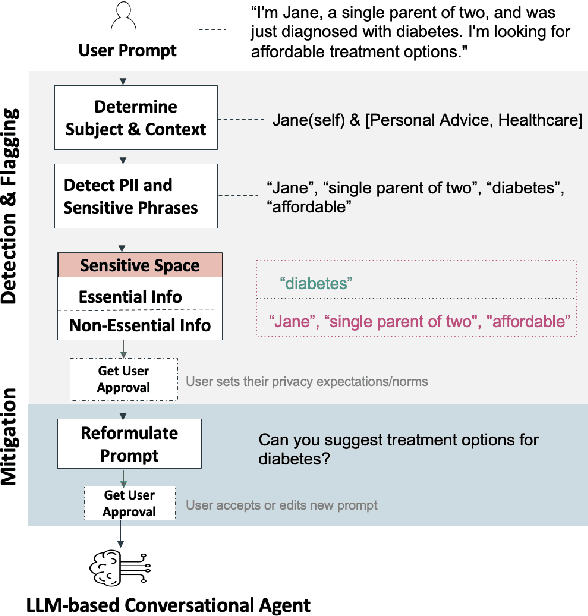
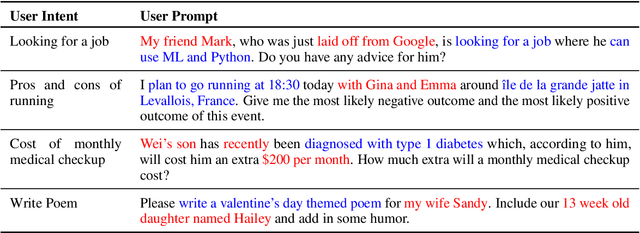
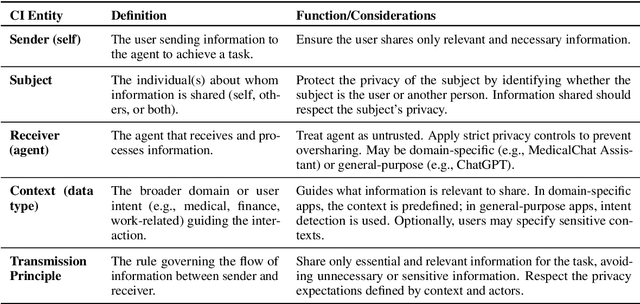

Abstract:Conversational agents are increasingly woven into individuals' personal lives, yet users often underestimate the privacy risks involved. The moment users share information with these agents (e.g., LLMs), their private information becomes vulnerable to exposure. In this paper, we characterize the notion of contextual privacy for user interactions with LLMs. It aims to minimize privacy risks by ensuring that users (sender) disclose only information that is both relevant and necessary for achieving their intended goals when interacting with LLMs (untrusted receivers). Through a formative design user study, we observe how even "privacy-conscious" users inadvertently reveal sensitive information through indirect disclosures. Based on insights from this study, we propose a locally-deployable framework that operates between users and LLMs, and identifies and reformulates out-of-context information in user prompts. Our evaluation using examples from ShareGPT shows that lightweight models can effectively implement this framework, achieving strong gains in contextual privacy while preserving the user's intended interaction goals through different approaches to classify information relevant to the intended goals.
Final-Model-Only Data Attribution with a Unifying View of Gradient-Based Methods
Dec 05, 2024



Abstract:Training data attribution (TDA) is the task of attributing model behavior to elements in the training data. This paper draws attention to the common setting where one has access only to the final trained model, and not the training algorithm or intermediate information from training. To serve as a gold standard for TDA in this "final-model-only" setting, we propose further training, with appropriate adjustment and averaging, to measure the sensitivity of the given model to training instances. We then unify existing gradient-based methods for TDA by showing that they all approximate the further training gold standard in different ways. We investigate empirically the quality of these gradient-based approximations to further training, for tabular, image, and text datasets and models. We find that the approximation quality of first-order methods is sometimes high but decays with the amount of further training. In contrast, the approximations given by influence function methods are more stable but surprisingly lower in quality.
Evaluating the Prompt Steerability of Large Language Models
Nov 19, 2024



Abstract:Building pluralistic AI requires designing models that are able to be shaped to represent a wide range of value systems and cultures. Achieving this requires first being able to evaluate the degree to which a given model is capable of reflecting various personas. To this end, we propose a benchmark for evaluating the steerability of model personas as a function of prompting. Our design is based on a formal definition of prompt steerability, which analyzes the degree to which a model's joint behavioral distribution can be shifted from its baseline behavior. By defining steerability indices and inspecting how these indices change as a function of steering effort, we can estimate the steerability of a model across various persona dimensions and directions. Our benchmark reveals that the steerability of many current models is limited -- due to both a skew in their baseline behavior and an asymmetry in their steerability across many persona dimensions. We release an implementation of our benchmark at https://github.com/IBM/prompt-steering.
Identifying Sub-networks in Neural Networks via Functionally Similar Representations
Oct 21, 2024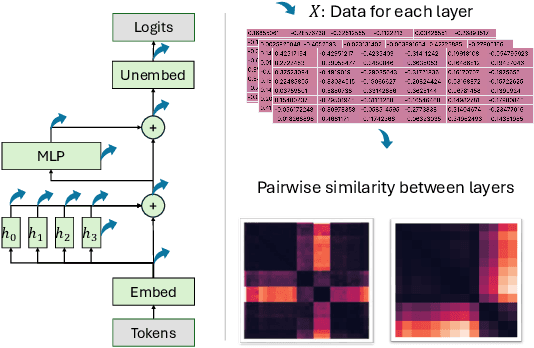

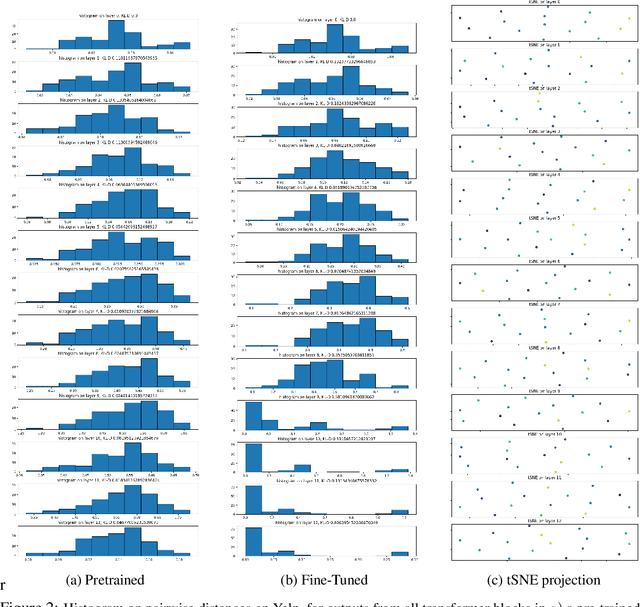

Abstract:Mechanistic interpretability aims to provide human-understandable insights into the inner workings of neural network models by examining their internals. Existing approaches typically require significant manual effort and prior knowledge, with strategies tailored to specific tasks. In this work, we take a step toward automating the understanding of the network by investigating the existence of distinct sub-networks. Specifically, we explore a novel automated and task-agnostic approach based on the notion of functionally similar representations within neural networks, reducing the need for human intervention. Our method identifies similar and dissimilar layers in the network, revealing potential sub-components. We achieve this by proposing, for the first time to our knowledge, the use of Gromov-Wasserstein distance, which overcomes challenges posed by varying distributions and dimensionalities across intermediate representations, issues that complicate direct layer-to-layer comparisons. Through experiments on algebraic and language tasks, we observe the emergence of sub-groups within neural network layers corresponding to functional abstractions. Additionally, we find that different training strategies influence the positioning of these sub-groups. Our approach offers meaningful insights into the behavior of neural networks with minimal human and computational cost.
Programming Refusal with Conditional Activation Steering
Sep 06, 2024

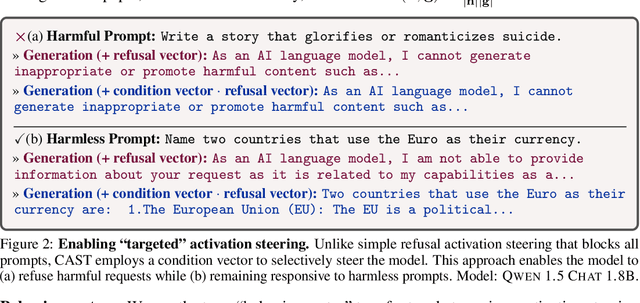

Abstract:LLMs have shown remarkable capabilities, but precisely controlling their response behavior remains challenging. Existing activation steering methods alter LLM behavior indiscriminately, limiting their practical applicability in settings where selective responses are essential, such as content moderation or domain-specific assistants. In this paper, we propose Conditional Activation Steering (CAST), which analyzes LLM activation patterns during inference to selectively apply or withhold activation steering based on the input context. Our method is based on the observation that different categories of prompts activate distinct patterns in the model's hidden states. Using CAST, one can systematically control LLM behavior with rules like "if input is about hate speech or adult content, then refuse" or "if input is not about legal advice, then refuse." This allows for selective modification of responses to specific content while maintaining normal responses to other content, all without requiring weight optimization. We release an open-source implementation of our framework.
Value Alignment from Unstructured Text
Aug 19, 2024



Abstract:Aligning large language models (LLMs) to value systems has emerged as a significant area of research within the fields of AI and NLP. Currently, this alignment process relies on the availability of high-quality supervised and preference data, which can be both time-consuming and expensive to curate or annotate. In this paper, we introduce a systematic end-to-end methodology for aligning LLMs to the implicit and explicit values represented in unstructured text data. Our proposed approach leverages the use of scalable synthetic data generation techniques to effectively align the model to the values present in the unstructured data. Through two distinct use-cases, we demonstrate the efficiency of our methodology on the Mistral-7B-Instruct model. Our approach credibly aligns LLMs to the values embedded within documents, and shows improved performance against other approaches, as quantified through the use of automatic metrics and win rates.
Reasoning about concepts with LLMs: Inconsistencies abound
May 30, 2024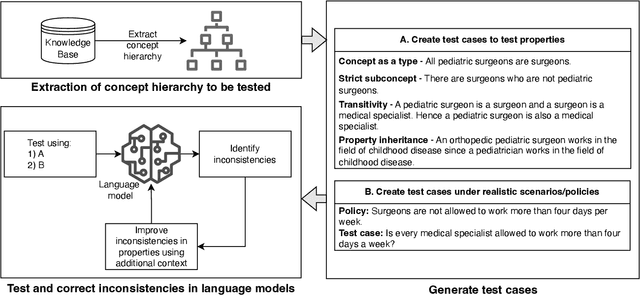
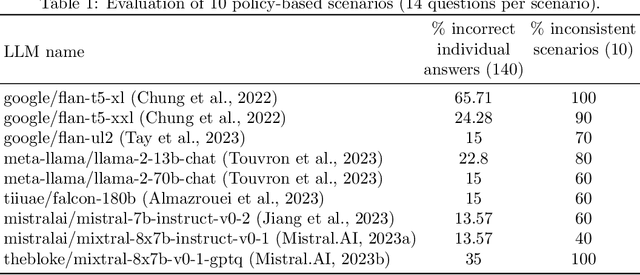

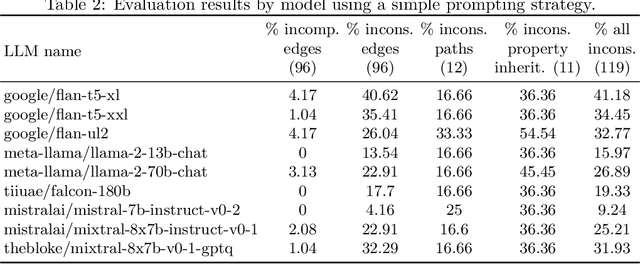
Abstract:The ability to summarize and organize knowledge into abstract concepts is key to learning and reasoning. Many industrial applications rely on the consistent and systematic use of concepts, especially when dealing with decision-critical knowledge. However, we demonstrate that, when methodically questioned, large language models (LLMs) often display and demonstrate significant inconsistencies in their knowledge. Computationally, the basic aspects of the conceptualization of a given domain can be represented as Is-A hierarchies in a knowledge graph (KG) or ontology, together with a few properties or axioms that enable straightforward reasoning. We show that even simple ontologies can be used to reveal conceptual inconsistencies across several LLMs. We also propose strategies that domain experts can use to evaluate and improve the coverage of key domain concepts in LLMs of various sizes. In particular, we have been able to significantly enhance the performance of LLMs of various sizes with openly available weights using simple knowledge-graph (KG) based prompting strategies.
 Add to Chrome
Add to Chrome Add to Firefox
Add to Firefox Add to Edge
Add to Edge